Boone Exposed Lakebed: An Owner’s Guide
Not sure what you can and can't do on newly exposed lakebed near your home? You may find the answers among these frequently asked questions.
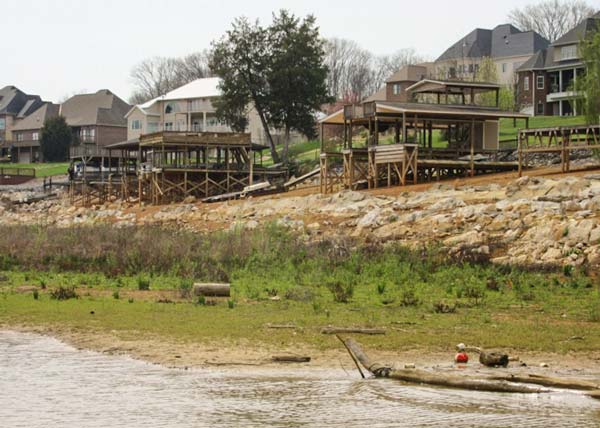
Lower water levels from the Boone Dam Project safety activities have left many lake front property owners with additional areas of exposed lakebed. These owners get to enjoy the exclusive right to use these exposed areas as private property; however, this added benefit comes with added responsibility.
Homeowners in the Boone Lake area may have questions on how best to protect these areas since vegetation along lake shorelines plays an essential role in maintaining water quality by filtering water that runs off the land surface. Whether dry or submerged, this vegetation also provides important fish and wildlife habitat and protects the exposed lakebed from erosion caused by wind and wave action. When lake levels rise again, the gravel, rocks, plants and downed trees seen on exposed lakebed, will provide habitat for fish to spawn, feed and find shelter.
Below are answers to the most frequently asked questions relating to what is allowed on exposed lakebeds. This document should provide homeowners with management practices that will provide protection for water quality and wildlife habitat throughout
the Boone Lake.
What defines the lakebed?
Exposed lakebeds are lands that lie below the ordinary high water mark (OHWM). The OHWM is defined as the top of normal summer pool level of a waterway. The OHWM doesn't change with temporary fluctuations in water levels, nor is it always at or near open water. For Boone Lake this OHWM would be located at elevation 1,382 ft. The OHWM is determined by state and federal agencies and not predicted to change during the lowered lake levels. This area below the OHWM is held in trust for the public. Although privately owned, it is protected by state/federal laws. Activities in these areas are limited and may require approval and/or permit(s) even when high and dry for an extended period of time.
What does the ordinary high water mark look like?
The ordinary high water mark (OHWM) defined above is often recognized by shoreline characteristic features such as:
- Rock riprap, sloping banks and other such features are likely at—or just above—the OHWM.
- There is a transition from established mature trees to non-woody or very young plants.
- There are prominent water stains on permanent structures that indicate the OHWM.
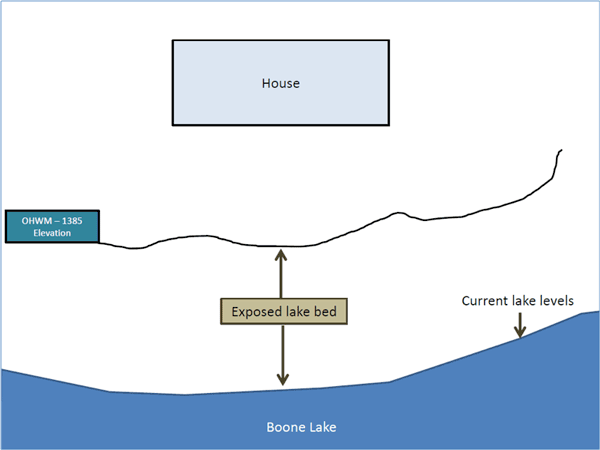
Who should I contact for information about activities I want to do on the lakebed?
Areas below the historic OHWM (elev. 1,382 ft.) would be under the permit jurisdiction of several state and federal agencies. These agencies work together to maintain and improve water quality throughout the Tennessee Valley. In some cases, depending on the proposed activities, you may need one or more permits. Below is a list of these agencies, including a description of their roles in permitting these activities:
Tennessee Valley Authority (TVA)
TVA reviews more than 2,000 construction proposals each year to ensure that shoreline construction activities are compatible with all aspects of TVA’s integrated management of the river system, including flood control, land use, recreation, power generation and water quality management. Section 26a requires that approval be obtained before any construction activities are carried out that may affect, in any way, TVA’s management of the Tennessee River watershed—including its reservoirs and tributaries.
Tennessee Department of Environment and Conservation (TDEC)
Persons who wish to make an alteration to a stream, river, lake or wetland (this would include property below elevation 1,382 ft.) or their shorelines in many cases must first obtain a water quality permit from TDEC. Physical alterations to properties of waters of the state require an Aquatic Resource Alteration Permit (ARAP) or a §401 Water Quality Certification. Examples of these activities would include: grubbing, disturbance, filling with rock or soil, dredging or removing soil, re-grading, re-sloping, construction of temporary or permanent structures, recreation prospecting, etc. You can reach TDEC by phone at (888) 891-8332 or email questions to ask.tdec@tn.gov.
U.S. Army Corps of Engineers (USACE)
This agency regulates activities including construction (building or placing fill) and dredging (removal of dirt) in the nation's navigable waters. Also referred to as a 404 permit, this permit is needed with the 26A permit and ARAP permit. The U.S. Army Corps of Engineers (USACE) has regulatory responsibilities pursuant to Section 10 of the Rivers and Harbors Act of 1899 (Section 10 RHA) and Section 404 of the Clean Water Act (Section 404 CWA). Under Section 10, the USACE regulates any work in, or affecting, navigable waters of the U.S. Under Section 404, the USACE regulates the discharge of dredged and/or fill material into waters of the U.S., including wetlands. Activities below the ordinary high water mark of Boone Lake would require authorization from USACE under Section 10 RHA and Section 404 CWA. Click here for a list of USACE Nationwide Permits. For work below the OHWM with minimal impacts, or for private fixed and floating boat docks on Boone Reservoir, click here to learn more about Regional Permit 13RP-01.
Tennessee Department of Agriculture (TDA)
Tennessee’s law that governs the custom application of herbicides and pesticides is "The Tennessee Application of Pesticides Act" (TAPA), and there are published rules that coincide with the law. To spray vegetation along the shoreline or exposed lakebed you would need permission or certification from TDA.
Tennessee Wildlife Resource Agency (TWRA)
In addition to monitoring fish population through annual surveys, TWRA works with the public to improve fish habitats and to maintain healthy habitat conditions. TWRA's habitat enhancement projects for reservoirs fall into several categories: shoreline stabilization, aquatic macrophyte establishment, and fish attractor construction. Each of these categories has different objectives, but all are aimed at maintaining current conditions or improving conditions for fish and fishing.
Can I remove the vegetation growing on my property in these exposed lakebeds?
Yes, you can remove it by hand, use a lawn mower, weed eater or a tractor to mow down the vegetation above the ground without a TDEC, TVA or USACE permit. When using motorized equipment please mow when the ground has been dry for an adequate time to avoid rutting and disturbance. Individual trees along the immediate lake shore above the OHWM may be pruned or cut provided the stumps and roots are left in place to stabilize the shoreline. Wholesale cutting of trees along the shoreline is highly discouraged as they provide shade, habitat and stabilize the shoreline.
What do I do with vegetation I've removed from my lakebed property?
The cut or collected material can be left in place, burned or removed.
Leaving in Place:
There is no requirement for you to remove material that accumulates along the shoreline. In many cases, over time, the material decomposes adding nutrients to soil. However, please keep in mind that you cannot actively push the material back out into the water.
Burning:
Burning “wood waste” and vegetation collected from your own property—not brought in from other sites—is allowed on your own property as long as the local county permits it. “Wood waste” is defined by TDEC as any product which has not lost its basic character as wood—such as bark, sawdust, chips and chemically untreated lumber whose “disposition” by open burning is to solely get rid of or destroy. This should only be vegetation, and not household trash, tires or building debris (see definition for wood waste at back).
There are times during the year when open burning is not allowed, and special burn conditions must be met and/or a permit may be required. This permit is free. Before you burn any vegetation please contact your local county forestry division to find out if there is a ban on open burning and to obtain a free permit:
Sullivan County (423) 239-5811
Washington County (423) 753-4011
Key safety practices when planning to burn any items:
- Notify your local fire department and neighbors of your plans to burn
- Do not burn on windy days
- Stay abreast of changing weather conditions
- Establish wide control lines down to bare mineral soil at least five feet wide around burn piles
- Keep fire containment equipment on hand during the fire (such as rakes, shovels, water)
- Stay with the fire until it is completely out
Removing:
Remove and disposed of this material in an upland location or simply place in the garbage. When removing materials please be wary of exotic species such as phragmites and purple loosestrife (pictured below—phragmites on top, loosestrife on bottom). It is important to dispose of these plants so they don’t spread to other areas. One way to do this, aside from burning, is to bag up the cut invasive materials, mark the bags with “Invasive plant species for disposal” and send them to a landfill.
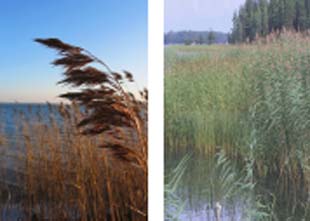
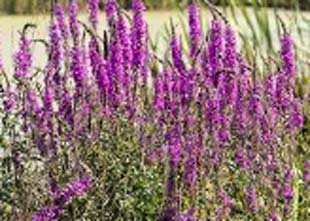
Can I spray chemicals or herbicides on vegetation on my property?
Chemical treatment of vegetation within the OHWM is not recommended and may require a certification for applicators and a permit from TDEC and/or TDA. Prior to using herbicides in these exposed areas, ensure you have considered all non-chemical options. The chemicals used in many weed killers can last for many years in the soil and cause damage to the environment and to the health of people who come into contact with them. If permission is granted for application of an herbicide, all application rates must be followed according to the label and an aquatic safe product must be used. Application should only occur during recommended weather conditions. Herbicide chemicals can easily drift out of your yard-application area, wash away into nearby waterways or travel down into the groundwater supply to hurt humans, wildlife or non-targeted plants. Application permits are always required if you are using a motor vehicle on the exposed lakebed or if the proposed treatment area is wet at the time of treatment.
Can I add dirt or top soil and try to seed and plant grasses on exposed lakebed of my property?
It is not recommended that homeowners add soils and fertilizers to plant common lawn grasses and maintain these areas as upland lawns. This is a very important ecological area. TWRA is working with Boone lake residents to voluntarily plant species of plants and flowers that grow well in clays and other riverbed soils without amendments. To deter erosion on the exposed shoreline at Boone, property owners can sow annual rye grass. This variety tends to germinate quickly, even during cooler fall temperatures. The rye grass should provide a good ground cover that will last through the winter months. During spring, a longer-term solution would be to use one or more of the following types of native vegetation (see more in the column at right): Switch grass, little bluestem, Indian grass, cardinal flower, coneflower, sunflower or milkweed. All of these varieties will provide effective erosion control with lower maintenance requirements and will not create any navigational hazards when water levels return to normal on Boone. These plantings will also be beneficial to fish habitat. Please contact TWRA with any additional questions.
What can I do with organic material that washes up on my property like mussels, algae, wood or dead fish?
You may remove washed up organic debris, including algae, mussels and dead fish by hand without any TWRA, TVA or TDEC permits. This means that you can use a shovel, rake, wheelbarrow, etc. to pick up and remove this material. The material must be removed and disposed of in an upland location (not in any waterway or wetland). For nuisance levels of this type of material that require motorized equipment to remove, please contact TDEC for proper applicable permit information.
Can I remove buried logs and/or rocks and stones on exposed lakebed?
Removal of logs and rocks is not permitted without a permit from TDEC and possibly other agencies depending on what you would like to do on your property. Areas of scattered rock and stone along the shoreline often serve as fish spawning areas and submerged logs function as excellent habitat for fish and other aquatic animals. When lake water levels return to normal or above normal conditions, submerged or partially submerged logs will buffer the shoreline from waves helping to protect your shoreline from erosion. These areas also could have cultural significance.
I found something unusual looking on my property—what should I do with it?
The Tennessee Valley is rich in cultural resources—archaeological and historic sites, historic buildings and structures, cemeteries and other remnants from our past. These resources are precious—finite and nonrenewable. That’s why TVA plays an active role in protecting more than 11,500 archaeological sites on over 293,000 acres of land and 470,000 acres of inundated land. In order to preserve our cultural resources, the use of metal detectors on TVA property is prohibited. We ask property owners to not disturb any cultural items found on their property and please notify the Tennessee Division of Archaeology at (615) 741-1588 if you suspect you have culturally significant items on your property.
Under Tennessee law it is illegal to disturb or destroy graves, regardless of their age or the condition in which they are discovered. These protections also apply to all grave monuments and burial artifacts. Anyone encountering a possible burial site or cemetery should immediately cease any ground-disturbing activity and contact the Tennessee Division of Archaeology, the county medical examiner and the local police or county sheriff.
TVA also reminds the public that it is illegal to remove, disturb, dig or damage historical or cultural artifacts on federal property as well as search on others private property without permission, including items exposed on land normally covered by water. The public is asked to leave such materials in place and report anyone digging for artifacts to the TVA Police at (855) 476-2489. In order to preserve our cultural resources, the use of metal detectors on TVA property is prohibited.
Can I place dirt, sand or rocks on exposed lakebed or regrade the slope on my property to make it easier to walk down?
The disturbance and placement of any fill—such as dirt, sand, rocks or pea gravel—at or below the OHWM may possibly require permits from TDEC, TVA and/or the Army Corps of Engineers.
Placement of soil and rock fill above the OHWM may require a section 26a permit from TVA if within the flood plain, as well as additional permits and permissions may be required from TDEC, as well as county or local zoning units of government. If you disturb one acre or greater of land (above or below the OHWM) then you will need a construction stormwater permit from TDEC.
Can I place downed wood in the lake or on exposed lakebed?
Natural trees that drop into water are fairly common as the trees die that grew along the shoreline. This coarse wood is a very important habitat component of a sustainable fisheries, and provides a home for aquatic invertebrates. This component of the shallow water habitat is often missing where logging has occurred in past years or where woods were unadvisedly removed. So, if a tree falls on exposed lakebed it should remain. The purposeful sinking of trees in deep water must follow certain requirements and might require a section 26A permit. Please contact TVA for additional information.
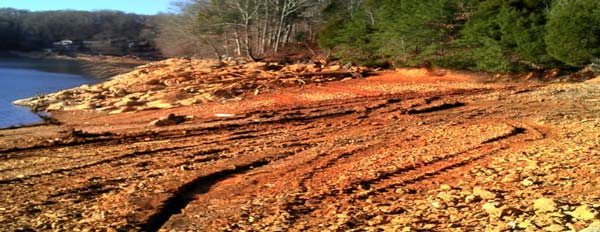
Can Boone Lake property owners deny individuals the right to cross the dry lake area on their property?
The majority of Boone Lake properties (above and below water) are privately owned, and TVA has obtained flowage rights. Unless TVA has reserved rights for the public, crossing private property is generally a civil matter and may involve private trespass issues. Local law enforcement may need to be involved.
Property owners should be reminded that, if they decide to use certain measures to prevent trespassing (such as signage, fencing, etc.), those measures could become subject to TVA’s section 26a regulations, which require TVA approval be obtained before any construction or other alterations are carried out that affect navigation, flood control or public lands along the shoreline of TVA lakes or in the Tennessee River or its tributaries.
Can I drive a motorized vehicle on exposed lakebed for recreation?
Not for recreation. Using motorized equipment and vehicles—including golf carts, ATVs, automobiles, etc.—for recreation on the exposed bed of a public waterway is prohibited except in very few limited circumstances. The exposed lakebeds are also private property; this is not an open or public area for recreation. The rutting from tires and disturbance often increases storm water sediment run off.
Will TVA be mowing or removing vegetation before the water returns to normal levels?
TVA mulched with skid steers in 2019 and plans to mulch again in 2020.
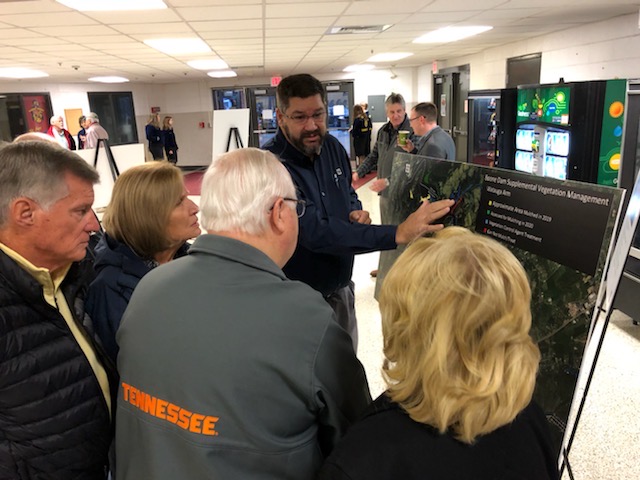
Vegetation maps like those shown during the TVA public meeting are available above.
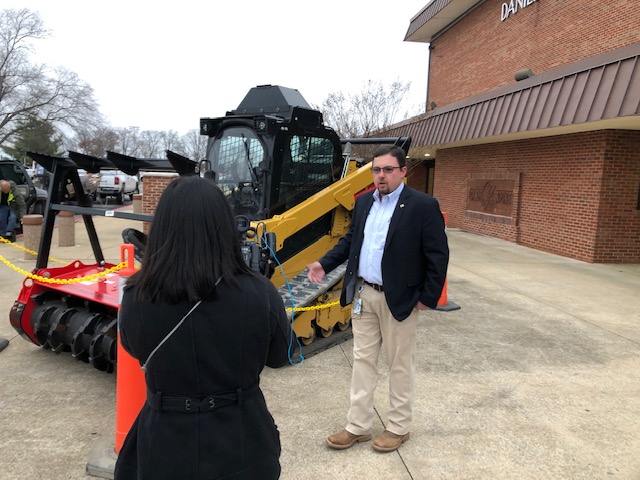
Senior Construction Manager Kevin Holbrook addresses the media in front of a skid steer.